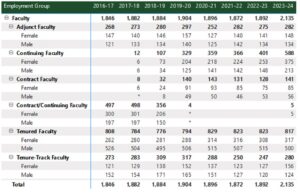How People across Campus can Access CSU Data to Inform Equity Conversations
The Office of Institutional Research Planning and Effectiveness (IRP&E) reports through the provost’s office and is a service office that serves the university as its official reporting source. We also support campus by providing data and analysis that helps keep our policies and practices data informed. IRP&E’s role is to provide accurate and actionable data to inform campus conversations to move CSU closer to strategic goals. I get to serve as the director of Institutional Research (IR) as well as support the Faculty Success group in their mission to improve equity in academic work by effecting cultural and structural change at CSU. My intent in writing this blog is to provide an example of an analysis with published IR data and how those data can contribute to campus conversations.
I want to start with a little about myself to position my identities within equity work and name important data limitations. Professionally, I love working with and interpreting data, but I also believe there is subjectivity in data. For example, systemic structural issues are replicated because we often use historical data to guide future decisions and make predictions. We can also create bias in the way we present statistics. Personally, I identify as a White, cis-female who works in a field (IR) with a majority of white woman. These identities are particularly important to recognize when we think about the limitations of the data produced by IR offices. For instance, gender and race as the federal government defines these identities are not inclusive of all folks. We often make conclusions about differences across these identities without the depth of information (e.g., caregiver or ability status) that captures the variety of lived experiences for folks that might be grouped together under the banner of “female” or as “Black”. I want to start this blog by acknowledging my positionality and the data limitations, not to disregard these data because they aren’t perfect, but rather so the limitations can be taken into consideration when interpreting these results in our institutional context. I also recognize that my push to find value in these imperfect data is biased by my privileges as an individual that doesn’t identify with attributes that are blatantly ignored with statistics. This professional and personal tension is the reason why I love that CSU is data-informed (rather than being myopically “driven” by the data), because it is through our shared understanding of IR data that we can make positive change.
Digging into the Data: Faculty and Staff Headcounts
IRP&E’s uses Power BI to present interactive reports that allow faculty and staff to sort and filter student, course, degree, and faculty/staff data in a variety of ways to help inform conversations. These reports all require a CSU net ID login and are only accessible to faculty or staff (students need to have the Microsoft licensing upgraded to access the reports, which comes with a fee). We don’t have any trainings up on the tool, but the report structure has stayed consistent across the variety of BI tools we have utilized recently. If you do have any questions on the data or how to use the tool, please reach out to myself or any of my IRP&E colleagues.
The first report I am going to review is an employee headcount and Full Time Equivalency report. These data can be filtered by fiscal year, division, department, or by employee type. This allows folks to review data for their unit or for a certain employee group. The data can be sorted (across as columns or vertically by rows) by a variety of employment (division, department, full time/part time, employment type or faculty rank) or demographic (gender, ethnicity, racially minoritized status) characteristics. The data in the table below can be downloaded into excel if you click on a cell in the table and then on the “…” that will appear in the right-hand corner to “export” data. I recommend exporting as “summarized data” so you can play with the crosstabs by using a pivot or if you want a copy of the table in excel then download “data with current layout”.
This first table shows employment group headcount (e.g. state classified, administrative professional, faculty, graduate assistant, and other salaried ) by gender over time. From these data we can see that the representation of female-identified faculty has increased from about 46% in 2014-15 to 51% in 2023-24 (a 5 percentage point increase).

Subsequently, in the second table, I filtered the data by faculty and added “employment type” as the second sort and gender as third sort down. From these data, we can see that female representation is much higher among contract, continuing, and adjunct (CCA) faculty compared to tenure-track/tenured (TTT) faculty. However, among CCA, faculty the representation of female-identified faculty has been steady, around 60% between 2014-15 and 2023-24. Interestingly, female representation has increased among TTT faculty (about 6 percentage points), from 37% in 2014-15 to 43% in 2023-24. Additionally, the percent of faculty that are CCA has increased from 40% in 2014-15 to 48% in 2023-24 (about 8 percentage points).

My interpretation is that the increase in representation of female-identified faculty is because representation among CCA faculty has increased as well as among TTT faculty. However, female faculty remain underrepresented among TTT faculty when compared with CCA faculty. The IRP&E data don’t shed much light on why CCA representation among faculty has increased or why female representation is higher among CCA faculty. These data points can inform our campus conversations about equity. These data can be disaggregated down to the college or department level and are provided in diversity blueprints to encourage units to explores patterns of representation and discuss institutional culture and structures that might support faculty that are historically underserved by higher education.
Author Information: This blog post was written by Heather Novack. Heather is the director of Institutional Research and a member of the Faculty Success Team.
